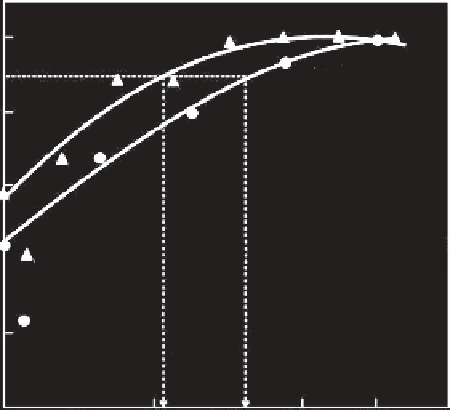Agriculture Reference
In-Depth Information
and application. Hence, NH
3
is not a popular N carrier in developing countries. Stanford (1973)
and Campbell et al. (1993b) reported that ammonium nitrate is generally superior to urea, which
may volatilize easily.
Fageria et al. (2010, 2011a,b,c) conducted field and greenhouse experiments compared to ammo-
nium sulfate and urea as sources of N in upland and lowland rice production. Grain yield expressed
in relative yield was significantly increased by urea as well as ammonium sulfate fertilization and
the increase was in quadratic fashion (Figure 8.9). In fertilizer experiments, 90% of the relative
yield is considered as an economic index and this index was used to calculate an adequate N rate
(Figure 8.9). Based on 90% of the relative yield (corresponding to 5750 kg grain ha
−1
) which was
obtained with the application of 84 kg N ha
−1
in case of ammonium sulfate. Similarly, in the case
of urea, 90% of the relative grain yield (corresponding to 4811 kg grain ha
−1
) was obtained with the
application of 130 kg N ha
−1
.
Fageria et al. (2011c) also conducted a greenhouse experiment comparing ammonium sul-
fate and urea as sources of N in lowland rice production (Figure 8.10). Grain yield significantly
(P < 0.01) and quadratically increased with increasing N rate from 0 to 400 mg kg
−1
of soil by
ammonium sulfate as well as urea source. Maximum grain yield was obtained with the application
of 168 mg N kg
−1
of soil by ammonium sulfate and 152 mg N kg
−1
of soil by urea. The variation in
grain yield was 5.5-22.8 g plant
−1
, with an average yield of 15.9 g plant
−1
by ammonium sulfate and
8.0-19.7 g plant
−1
, with an average value of 14.4 g plant
−1
by urea fertilization. Ammonium sulfate
accounted for 90% variability in grain yield, whereas urea accounted for 78% variability in grain
yield. Across six N rates, ammonium sulfate produced a 10% higher grain yield compared to urea.
In addition, average across two N sources (160 mg N kg
−1
), ammonium sulfate produced 22.5 g
grain yield per plant and urea produced 18.5 g grain yield per plant. The application of ammonium
sulfate at the rate of 160 mg N kg
−1
produced a 22% higher grain yield compared to urea at the
same rate of N. This means that ammonium sulfate was a superior fertilizer for lowland rice grain
yield compared to urea.
Ammonium sulfate
100
90% of maximum yield
80
60
Ammonium sulfate (Y) = 57.00 + 0.5146X - 0.00149X
2
40
R
2
= 0.9663**
Urea (Y) = 44.9714 + 0.4511X - 0.00088X
2
20
R
2
= 0.9932**
0
40
80
120
160
200
Nitrogen application rate (kg N ha
-1
)
FIGURE 8.9
Relative grain yield of lowland rice as influenced by ammonium sulfate and urea fertilization.
(From Fageria, N. K., A. B. Santos, and M. F. Moraes. 2010.
Commun. Soil Sci. Plant Anal
. 41:1565-1575.
With permission.)

